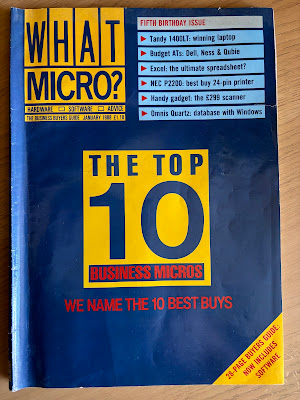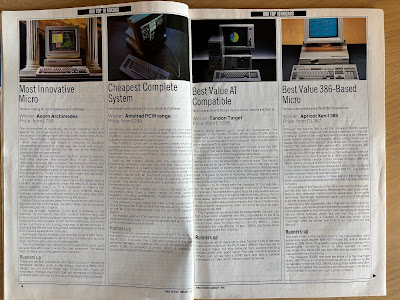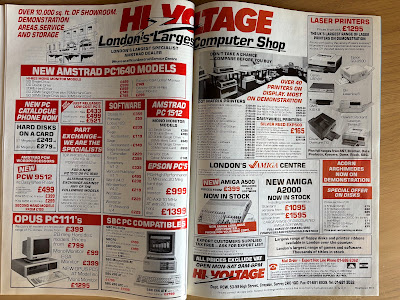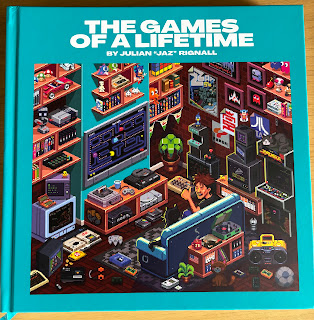What other way for What Micro? to celebrate its fifth birthday than with a declaration of the top ten business machines then available on the market. Given the date, you might be surprised by one or two of the selections, but hey, it was the 80's, and a time that, for computer fans in the UK at least, meant that the 16-bit generation was beginning to hit its stride.
But first, the news...
Amstrad had launched their portable range, although at 12lbs, the PPC's stretched the definition of portable. Starting at £399 ex for a single floppy, 512Kb model, rising to £499 ex for 640Kb, and an extra £100 each for another floppy (which would make life a hell of a lot easier), these were very competitively priced. That the PPC640 rocked a 2,400 baud modem was a cherry on top. Sure, the LCD was crap, and the keyboard simply mediocre, but if you had to have a computer for use at points A, B and beyond, they did the job.
Just as Epson's portable could, and with a smaller, but not overly lighter, form factor. There again, that would set you back £1,395 where as a similarly spec'd PPC640 would do you for £599. You pays your money and all that...
The same goes for Apple, and a lot of money too! Even with cuts of up to £300, a hard disk equipped SE would still leave you £2,895 worse off, although the basic Plus was £200 lighter at £1,795 - a veritable bargain... Of the more expandable Mac II, this was a case of there being coughs, near and far. A mono HD model for £5,195 was definitely a far cough moment.
Back in the clone world, Compaq were trying to tempt users to the joys of VGA graphics, but while you may think that £400 for just the card to get 640x480 at 256 colours was a bit steep, that was a snip considering the accompanying colour monitor was £505. A mono-VGA tube was only £205, but surely you'd never pay that much for a graphics card and not experience glorious technicolour? There again, that £400 in late 1987 is now just over half of the imaginary MSRP of the Nvidia RTX 5090 today!
Tandy were refreshing their range of machines, and although tempting business options, £595 for a basic 256Kb of RAM was a tad pricey. 640Kb would take the price to £795 with a mono monitor, and £995 for CGA. At this point, the 286 models seemed like a better bet at £895, and with greater expansion options too. Sadly, it was a tad early for the 386 to be anything other than a multi-user (see below) wonder, with the Tandy 4000 expected to start at £1,995 for a system with just a floppy and no monitor. A useable spec with a hard drive and mono screen began at £2,995, and EGA graphics added another £500.
AST talked of shipping a 20MHz 386, although prices were still to be confirmed. What you would do with a 386 as a single user was a more pertinent question, and providing justification of not spending the money. Meanwhile, Digital Research were upping their efforts to disappear slowly into history by releasing Concurrent DOS 386 2.0. Notable bragging rights were for up to 255 simultaneous tasks on a 386 machine with up to 4 (count 'em) gigabytes of memory, with each terminal user (for what else would you have this OS and such power for in 1988) able to run two MS-DOS programs at the same time. Not bad, but if you could afford that much memory in 1988, the cost of the attached 386 would have been just a mere rounding error.
VGA graphics got a proper mention with the release of more upgrade boards, although the cheapest still rocked in at £299 and you'd still need the relevant display on top.
The cover feature next, and by grouping the winners into ten categories, the What Micro? team have tried to cram in as many machines and formats as possible.
Amstrad won Best Budget IBM Compatible, which is no surprise although comment was made about how the higher end PC1640 with EGA style display option was worse value for money than its compatriots, coming in rather close to some 286 base systems. The 1640 was still better value than the 1512, and it's hard to disagree with that opinion in hindsight.
Fastest IBM Compatible went to the Compaq Deskpro 386/20, and when something starts at £5,225 ex VAT, it needed to fly off the proverbial shovel. IBM came close, as did the Mission 386.2 (nope, no idea either), but given the scarcity of 386 20MHz offerings out at the time, this was an easy win.
Most Innovative Micro next and, well, yes, yes it was, and I'm not hiding my favouritism at all here. The Acorn Archimedes beat the Amiga and IBM's PS/2 range for innovation. For its price, it was fast, highly specified, and only lacked software to make it truly fly. If only it had been that simple.
Cheapest Complete System feels like a section created for one reason and one reason only - the Amstrad PCW must be given its time in the spotlight. And you know what, for the late 1980's, if you wanted a home office system including a printer, there was no better value, and even the runners up section notes that the only real competitor to the £299 PCW would be a PC1512 and printer for about £600. Better, yes, but also double the price of the base PCW, and for that, Amstrad's CP/M wonder deserved its success.
Back to the PC world with the next two - Best Value AT Compatible and Best Value 386-based Micro. The former was a clear winner given it's from one of the "big" manufacturers, although a tad slow at 8MHz when the competition were turning the dial up to 10 and even 12MHz (Ludicrous speed indeed!). The latter was a timely win for Apricot, being both British (when such malarkey still mattered), and being a relatively long time solid company. Whilst not as fast as say IBM's offerings (which were £2k more expensive, albeit with better expansion options), the Xen-I 386 was seen as a safer bet than the small company offering the cheapest 386 at that time, the Stanhope Baby 386, yours for £2,290.
Laptops now (and Portables to come), with Zenith taking the honours for a 12 lb wonder that delivered a backlit LCD screen, something of a winner for any user. Toshiba, who would become synonymous with laptops as the 80's turned to the 90's, arrived as a runner up with their 1400LT - nearly half the price of the Zenith and suffering from only a squashed screen. Their more expensive models were considerations if you wanted more power (see below), and the Cambridge Z88 walked off with a nod to extreme portability.
Ah yes, power. For the true "portable" warrior, the Compaq Portable III and Portable 386 took the larger of the mobile categories. They were expensive (£3.5k plus), heavy (20lbs), and mains only, but if you needed the grunt, these were the ones for you. There were many other options for the form factor, some even rocking under a grand, but Toshiba's T3100 and T5100 (also considered as laptops), were good alternatives as long as you had access to a mains point.
The final two winners are the polar opposites of the era, Apple and IBM. Apple grabbed the Easiest to Use Micro award, which wasn't difficult to be fair, and with those new, "cheaper" prices... That, and it would take another year and a bit before the beauty that was RISC OS 2 descended from the heights for Archimedes owners... IBM had to settle for the Best Quality AT Compatible, which again wasn't difficult for the time. Yeah, the PS/2 Model 50 was expensive (£3,048 ex VAT), but you got some serious class for that outlay, with only Hewlett Packard and Compaq making up the rest of the running.
A varied mix, to be sure, the same of which could be said for the AT trio from Dell, Ness and Qubie. Starting at £1,085 with the Ness, the Qubie and Dell offerings clocked in at £1,330 and £1,364 ex respectively, and while none of the machines had any major failings, the key differentiator was the service package - Dell's was highly professional, whereas Ness provided the bare essentials. Whether the extra £300 was worth it for the Dell was the key question. That being said, adding EGA colour to the trio varied wildly in price - Qubie for £325, Dell for £400, and a relatively extortionate £460 from Ness.
Tandy's latest laptop came under the microscope, a 7.16MHz V20-powered device with 768Kb of memory and two (count 'em!) 720Kb 3.5" floppy drives. At £995 ex, it was a good value proposition compared to its rivals, yes, even the Amstrad PPC. Praise was given for the backlit LCD screen, and although there was a comment about the sheer value of Amstrad's offering (£499 for a similar spec), many would be better off spending more for the Tosh. To be fair, even now, I find the aesthetic really pleasing, although the idea of having a four hour battery life that required fifteen(!) hours to recharge from flat is a very 80's tech memory.
As this was the fifth anniversary issue, the next feature is an obvious inclusion - a review of major events of the first five years of the magazine's life. It's a good potted history and packed with nice little bon mots of data, such as Amstrad's claim that as of the writing of the article, they had sold 750,000 PCW's.
The In Brief section hosts a Lotus 1-2-3 competitor priced at under a tenner for the shareware version, and £30 for the full package including a manual, Graph in a Box (a pop up program that could create business graphics from a selection of data sources) was a £95 extra whose usefulness would be devalued as integrated packages came to the fore in the coming years, and Personnel Pal - not an A.I. People Services bot, thankfully, but more of a tech aid for personnel departments in their recruitment goals. No, not sure myself.
The big software review is for Microsoft Excel, a £395 titan of number crunching. Adhering to the Windows 2 aesthetic, it was a worthy alternative to Lotus 1-2-3, but only for those who could afford the price tag and rocked a hard drive-equipped AT with EGA graphics. Spoiler alert, but as the SBC ad below shows, that set up would be nearly two grand ex VAT, thank you very much, with both Windows and Excel as extras. Onmis Quartz (a database manager/language) and Q&A Write (a would be DOS-based Word competitor) round off the software reviews.
Hardware wise, NEC's budget (£395 was budget back then) 24-pin printer offered great value for money for the time, whereas the Cameron Handy Scanner was, for £299, limited in its black and white scanning abilities, but seemed good value compared to more feature-rich options if your needs were modest. The usual hardware guides and the like round off the editorial content, so now to the ads.
Commodore have the first eye-catching offer as they try to convince people to spend £499 (VAT inclusive) on their new Amiga 500. Even before the price cuts and bundles that would see the Amiga rule the 16-bit home computer world, albeit briefly before consoles and DOS/Windows machines took over, this was astoundingly good value, and as such, was a great home computer choice if you had the money. For business or home office use, there were (as you have seen above), more efficiently aligned (Lord, I've been hanging around managers too much!) options offering a more holistic approach to your computing requirements (Shoot me now!).
SBC (as previously mentioned), grab two pages for their DOS compatibles, and with fairly decent prices too. Kudos also for the ad that, although it looks rather "busy", manages to convey all the relevant information and the dealer network. The mention of Derwentside ITEC brings back memories too, as they were the school's first choice of work experience placement for several of us back in the day.
Amstrad have a go at trying to shift their DMP range of printers to business users, and yes, they were cheap, and no, they were not great, not even with that impressive 15" carriage (calm down at the back!).
Meanwhile, OKI (via Technitron Data) were trying their same, and to be fair to them, they had a much greater range (and prices), and were often a reasonable choice.
Our old favourite, Silica, pop up with an ST ad, and for £299, it was a great buy to those wanting to leave the 8-bit era behind, and at 60% of the cost of an Amiga.
Here's Elonex with their PC range, and although not the cheapest, by no way the most expensive, and they would become a regular name in group tests and awards round ups throughout the 90's, at least until they gave up on computers and went down the novelty tech route.
Hi-Voltage's spread has the usual Amstrad, Opus and SBC shenanigans. alongside the NEW Amiga A500 from £399 (ex, so don't get too excited, although still a discount), and the A2000. They even had the Acorn Archimedes on demonstration. Great news, and all that, but wait until prospective buyers saw the price tag...
Speaking of Cambridge's finest Anglo-Italian team, Acorn have an advert, placed lovingly(!) on the back cover, extolling the virtues of the A300 series. Ignore all of the asterisks, they're just copyright nods, and take note of not only the pricing (£795 ex for the half-meg 305 with mono monitor, £1,035 ex for the one-meg A310 with a colour display - i.e. the one you should have gone for!), but also of the 0% finance offer. Not a bad idea, considering the price, but for a maximum period of 12 months, you still had to have some serious incomings to afford nearly £1200 at £100 per month. Dealer prices were a smidge cheaper, but consider the 2025 equivalent (courtesy of the Bank of England inflation calculator) - a total of £3,400 equalling £283.54 per month just for a computer. That might even make some Apple fans wince these days! Back then, however, that didn't even cover the cost of a basic Mac Plus!
That, gentle reader, was January 1988 for What Micro?, and I feel the need to once again move away from the DOS-centric world for the next MoYY. The question is, what publication, and when from... Have you ever considered the aesthetic qualities of a kipper tie?




































